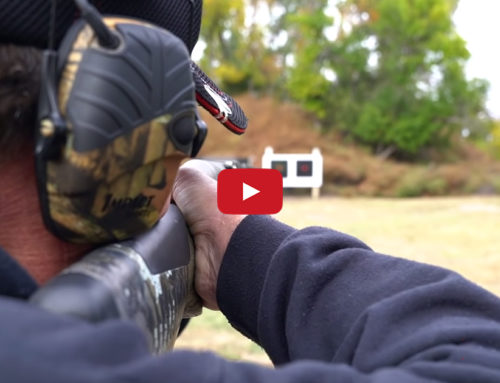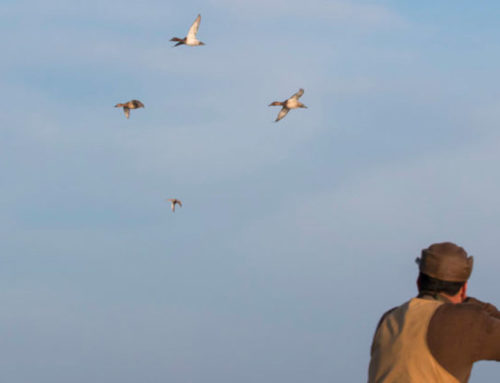
Barrel Length Ballistics

Adding or decreasing a few inches of barrel can enhance wingshooting
By Brad Fitzpatrick
I once asked a skilled skeet shooter why he strictly shot guns with 30-inch barrels. Certain that a long and detailed dissertation on barrel length would follow, I was a bit taken aback when the man looked at me, shrugged, and said, “I dunno, I just break more clays with 30-inch pipes than 28- or 32-inch barrels.”
There was no mention of balance, momentum, the Coriolis effect or anything. To that shooter, who has broken 100 clays straight, barrel length was a matter of feel. Surely, I thought, there had to be more to barrel length selection.
 That conversation occurred about 20 years ago, and in the intervening decades I’ve done my best to filter out the truth and lies regarding barrel length. I wanted to know, I suppose, whether the truth was as simple as my skeet champion friend had suggested or whether some deeper, more divine truth about barrel length could be unearthed. And while I don’t claim to have all of the answers, I’ll happily relate what I’ve absorbed from shooters, gun manufacturers and hunters regarding the science and mythology of barrel length selection.
That conversation occurred about 20 years ago, and in the intervening decades I’ve done my best to filter out the truth and lies regarding barrel length. I wanted to know, I suppose, whether the truth was as simple as my skeet champion friend had suggested or whether some deeper, more divine truth about barrel length could be unearthed. And while I don’t claim to have all of the answers, I’ll happily relate what I’ve absorbed from shooters, gun manufacturers and hunters regarding the science and mythology of barrel length selection.
Muzzle Velocity Myths
A few years ago, I was tasked with determining how barrel length impacted muzzle velocities in shotguns. Testing the muzzle velocity of a shotgun with a chronograph is an imperfect science, since shot comes out as a string rather than a single projectile. It’s possible for the chronograph to measure the velocity of the wad and not the pellets, but I would at least have a baseline to determine the relationship between barrel length and muzzle velocity. It’s the sort of thing that precision rifle shooters and their ballistic computers obsess over. But does barrel length affect shotgun muzzle velocity, and should we care?
For the velocity examination I tested 12 and 20-gauge shotguns with interchangeable barrels. I used 1 1/8-ounce target loads for the 12-gauge evaluation, and for the 20-gauge evaluation I tested 1-ounce small-game loads. Barrel lengths for the 12-gauge test were 22, 26, and 28 inches, and for the 20-gauge portion I tested 24-, 26- and 28-inch barrels. The results are shown here:

As you can see from these velocity figures measured on a chronograph at 10 feet from the muzzle, velocity is impacted very little by barrel length. If you’re convinced that the velocity of the projectiles that you’re firing from your gun with a 30-inch barrel is significantly more than the velocity of that same load from a 22-inch barrel, I hate to inform you that the data disagrees. Is there a difference between the velocities generated in a 22-inch barrel versus a 28-inch barrel? Yes. Is it statistically significant or relevant to field performance in waterfowl guns? Sorry, no.
Weights and Balances
Now that we’ve divorced ourselves from the notion that barrel length has any real impact on terminal performance in waterfowl shotguns, should we throw our hands up and say that barrel length is immaterial? Not at all.
Shotgun barrel length impacts the gun’s sight radius, weight and balance, and those factors will impact how well you shoot. A lengthened sight radius will help you shoot more accurately, but while the difference between a 22- and 30-inch barrel is quite pronounced and significantly affects your ability to hit a moving target, the difference between 26- and 28-inch barrels, and 28- and 30-inch barrels, is far less noticeable. A longer sight radius may help you pick up a bird from time to time, but it won’t make a bad shooter good nor a good shooter great, and so it isn’t one of the primary factors that should affect barrel length selection.
Weight does matter, and so does overall length. Long, heavy guns are a burden, but how much gun length and weight affect your success as a waterfowler depends upon the conditions under which you hunt. If you’re one of the rare breed of freelance waterfowlers who traipse great distances to hunt in far-flung pockets of public land, well, maybe gun weight and barrel length make a major difference in your success or failure. However, if you’re like me (and most of the other waterfowl hunters reading this) you probably walk less than a quarter mile to tuck into a blind that offers plenty of room for a 28- or 30-inch barrel. For the vast majority of us, gun weight and overall shotgun length are not factors of the utmost concern.
This leads us to the final and perhaps most important factor relating to barrel length — gun balance. How your gun balances depends on barrel length and construction as well as the gun’s length of pull. Somewhere between the gun’s muzzle and butt you’ll find the balance point, and most shooters do well with a gun that balances between their hands at the breech. Particularly if you’re tall (like the skeet shooter discussed earlier), longer barrels often strike a better balance between a nose-heavy gun (too much weight in the barrels) and a whippy gun (too much weight at the rear of the gun).
For more evidence that barrel length is primarily a byproduct of balance, let’s look to the world of competitive sporting clays. A few years ago, 34- and even 36-inch barrels were becoming more popular among sporting clays shooters. The idea, I suppose, is that a longer barrel made you shoot better. Pretty soon, however, the tide turned and shooters were retreating back to 30- and 32-inch barreled guns and away from nose-heavy stack barrels. It’s rare now to see competitive shotguns with 34-inch pipes. Caesar Guerini is one maker offering them, but Guerini USA president Wes Lang, himself a competition shooter, says Guerini can lighten the barrels so that 34-inch guns balance properly on the front hinge pin.
A Fitting Choice
So, was the old skeet shooter right? It appears so. If you’re a small-statured shooter with a short length of pull, then you’ll probably find your firearm balances better with a 26-inch barrel. If you have long arms and a correspondingly long length of pull, then a 30-inch barrel will work best. The odds-on favorite for 12-gauge shooters is a 28-inch barrel. It balances well for a wide range of shooters and most production stocks, and that’s why it’s the most popular barrel length for semi-auto duck guns.
But, as my friend said many years ago, you have to find what works for you. When you do, you’ll break more clays — and kill more birds.
Brad Fitzpatrick is shopping for his next 28-inch barrel shotgun in Marathon, Ohio.






Been waterfowl hunting for over Sixty years. I prefer long barrel guns in the blinds for safety number one, those very short barrels are too easy to move to point where you don’t want it. Second I like to get tie blast sound as far away from my old ears as possible. This may not be science but my experience. I use 30” barrels on my 12 gauges.
I00% agree. In some blinds there may be 6 hunters, they will shoot over head if there’s no roof. Another thing, extra length keeps the pattern tighter on longer distance shots.
Just became a member of Delta Waterfowl- really good stuff- been a member of DU for a number of years – can’t have too much conservation in the world of waterfowl
This only shows that these particular loads were optimized at 24-26 inch, and near the optimum small changes in length will have minimal effect. Other combinations of mass and powder(both amount and burn rate) will have different ideal barrel lengths. Now if most shotguns on the market are in that 24-30 inch range then most shell producers are going to design loads suited to that barrel length so it is a reasonable statement to say barrel length has little effect on velocity for the *typical load*, however this is very different from spouting a blanket statement that it is universally true.
You sound like a rifle guy (-:
I’d guess that 90% of shotgun hunters are buying shells off the shelf and would fit that “typical load” description very well. What you’re saying is true, but for a significant portion of the masses (me) the info in this article is both relevant and appreciated. I’m here because I want to get add a 20g to the safe and I wasn’t sure if I’d be giving up anything with a 26″ barrel, ballistics wise.
What? Shotgun shells are not optimized for barrel length, where on Earth are you getting this from?
It’s a fantastic and helpful piece of information. I’m glad you just shared this helpful information with us. Please continue to be informed in this manner. Thank you for sharing this information. Here’s some more useful information. hunters pattern their shotguns. More information can be found here.
I’ve been hunting waterfowl for over 40 years we started out using 30 inch barrels fixed chokes but screw in chokes changed all that now using 28 inch barrels when you shoot a goose dead is dead keep yardage respectable and it will do everything you want.
I hunt ducks and upland game with an 18″ barrel.
I personally thought this was a well thought out and researched analysis. I’ve always thought that, unlike a rifle, a typical shotgun would gain between 5 f/sec and 10 f/sec in muzzle velocity for each inch increase in barrel length. Probably closer to 5. Hardly enough to base a buying decision on. One factor that didn’t seem to get much play is “swing”. Probably best described as the momentum created by moving additional weight forward in the barrel. This may be one of the biggest factors to those who want to fill their freezers with clay fragments. It’s all about feel. I am about 5’ 10” ish and average build. I only use my shotgun for water fowl. I shoot a Benelli with a 30” barrel – a configuration usually associated with skeet and trap shooters or Amazons. I appreciate the feel of the longer barrel with my particular technique of leading. I like to come from behind the bird and work my way past it to find the ideal lead. It works for me and I’ve become so accustomed to the longer barrel, I look at it as an advantage.
I’ve never even considered the prospect of sight radius. That’s something I usually associate with iron sights on a .30-30 or a 7” .45. But it makes sense even on a shotgun.
Ya , why can’t anyone tell you how much more distance you receive with a 36 inch barrel using 3 or 3 1/2 inch shells in a 10 gage ? The question is at what height can a shotgun shoot down a drone ?